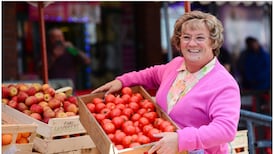Visual Arts:Geraldine O'Reilly's exhibition, A Circuitous Line, at the Civic Theatre Gallery in Tallaght, is a tale of four landscapes. In fact, you could say five landscapes, though the fifth, Inisheer, doesn't appear in the show. O'Reilly spent three rewarding years on the island, making drawings in Conté crayon. The very term "Conté crayon" has genteel associations, but not in this case. Her drawings were won directly from nature, made out in the open, exposed to the weather coming in from the Atlantic.
In conversation with the writer, Dermot Healy, she related how her Inisheer work reached its end, and how she came to leave the island. Someone liked one of the drawings she'd made, but it had sold, so she was persuaded to go and make a drawing from the same location.
After a day's work out on the rocks, she packed up to go home, fell over, was briefly unconscious and came to with a broken arm. She was flown to Galway, where her arm was set in plaster. Eventually, she got back to Inisheer and set out to work at the same spot again. Heading home at the end of the day, she fell and broke her ankle. There was another flight to Galway. "I decided I had enough," she remarks, reasonably. It really seemed as if the island was telling her it was time to go.
It is at this point that the work in A Circuitous Linepicks up the story. O'Reilly spent some time at the Ballinglen Arts Foundation in Ballycastle in north Co Mayo, where the shoreline landscape is stark and elemental. She began a series of paintings that situate us as viewers, and herself as the painter, at the edge of the land as it gives way precipitously to the expanse of the ocean. Several of these paintings feature in the Tallaght exhibition and they are very impressive.
They are beautiful in a subdued, almost sullen way, taking their cue from the quality of the place itself, which can seem worn by the relentless assault of wind, rain and sea. Her colour is toned down to moody, earthy greens and bruised grey-blues. In Bad Weather Forecast, North Mayo, the sky is stirred into an angry froth of killer clouds. Between Land, Sea and Sky, North Mayorepresents an opposite, calm, state with great sensitivity. There are fine studies, as well, of the densely stratified cliffs of Downpatrick Head.
Yet O'Reilly was somewhat dissatisfied with north Co Mayo, not because of any intrinsic drawbacks about the place but because she felt she was using it as a kind of substitute Inisheer. In perching at the edge, she was recreating the edgy situation she had favoured back on the island. The locations were different, and Co Mayo would never satisfactorily impersonate Inisheer. One is glad, though, that she spent time in this transitional space because the work she did there forms a fine addition to landscape paintings of the area.
In the meantime, she discovered the second landscape that features in A Circuitous Line, Coney Island in Co Sligo. It's an island of quite a different character from Inisheer. In the Conté drawings she made there, she was attracted to a particular field, an expanse of damp-looking ground in a hollow. Neither in these drawings, nor in an atmospheric study of a ruined lodge house, do we even glimpse the sea.
She feels that this experience, in somehow turning her away from the sea, set her on a course that would bring her back to the Midlands environment in which she grew up, and which provides the other two landscapes that feature in the exhibition.
As she puts it, that field on Coney Island became in time the back garden of her mother's house in Killucan, Co Westmeath, where she found herself living again. It is not, as it happens, the house in which she grew up, but it is nearby, a fact that presumably accounts for the Circuitous Line of the show's name. A back garden near Kinnegad is a prosaic subject compared to the drama and romanticism of the Aran Islands. Whereas the latter have a mythic resonance in the Irish imagination, and somehow embody an essence of Irishness, the Midlands, dominated by a great, uneventful limestone plain, have had a relatively bad press.
Yet O'Reilly's accounts of the garden are extremely lively and packed with incident. They're busy and intensely observed. It's just that the scale and the nature of the activity are of a different order to the epic space and constant transformations wrought by the weather on Inisheer. In Killucan, she is attentive to the rhythms of movement and chance on a daily and seasonal basis. She imparts a sense of a constant motif subject to small changes over time, and time is palpable in her evocations of a landscape of contained domesticity.
There is, however, another kind of landscape that features in her Midlands work, and that is the Royal Canal. While suburban housing has transformed much of the land and many of the towns near Dublin and other urban centres, she sets out to rediscover an authentically rural Midlands landscape that is still stubbornly intact, and she finds it in the canal and its adjacent vegetation.
Her canal drawings reveal a surprisingly expansive domain, with brilliant sheets of still water that bring the sky into the midst of the land, and lush tracts of profuse growth, masses of greens against tangled armatures of branches. There is a richness, an organic density that is quite different to the spare severity of Co Mayo and the poorness of the land on Coney Island. Yet there is also a unity to the exhibition as a whole, no sense of contradiction between one location and another. In leading us along A Circuitous Line, she has built a formidable body of work.
A Circuitous Line: Landscape Works by Geraldine O'Reilly, Alternative Entertainments Gallery, Civic Theatre, Tallaght, until Jan 21










